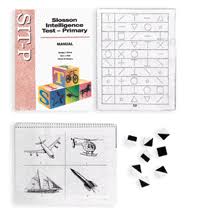SIT-P Complete Kit includes:
• Manual
• Lower Level Scoring Forms and
Response Booklets ( 25 of each)
• Upper Level Scoring Forms and
Response Booklets ( 25 of each)
• Picture Book ( with 23 plates)
• Blocks (Total of 8, l" with patterns)
The SIT-P is a new, brief, standardized screening test of children's intelligence. It is not just a lower extension of the SIT and SIT-R, but includes both Verbal and Performance items to give a balanced measure of a child's cognitive ability. The SIT-P was designed to facilitate the screening identification of children at risk of educational failure, to provide a quick estimate of mental ability, and to identify children who may be appropriate candidates for deeper testing services. The SIT-P can be easily administered by professionals and paraprofessionals with appropriate training and supervision. Appropriate settings include schools, clinics, and organizations whose interests include estimating an individual's cognitive ability.
Test administrators will find the SIT-P to be a very current and adaptable screening test.
A wide range of Verbal/Perceptual Speed/Block Design Nisual-Motor/Performance items yield two scaled Verbal and Performance standard scores which combined form a Total Standard Score (TSS), to very quickly give the administrator an overall picture of a young person's cognitive abilities.
CrystalIized ability is that intellectual skill that enables the individual to cope with their environment. With two levels, an Upper and Lower Level, each contain 121 items that test one's Crystallized ability. Items are ordered with an approximate ascending degree of difficulty. Items are read to the examinee and the respondent answers verbally without the use of a pencil, paper, or other aids. The test yields Verbal and Performance Subscale Scores and a Total Standard Score (TSS), percentile ranks, and age equivalents.
The Verbal Items of the Crystallized Ability:
• Vocabulary
• Similarities and Differences
• Digit Sequences
• Sentence Memory
• Quantitative Skills
The Fluid Performance Items of Nonverbal Abilities include:
• Fine Motor and Gross Motor: stacking blocks, locomotion (walking, running) and coordination (dexterity, geometric patterns).
• Block Design: Lower Level and Upper Level (40 items). Includes blocks with patterns
on each side. Child is asked to "make the tops of your blocks look like the blocks in this picture."
• Perceptual Motor Speed: Upper Level (40 items). Symbol search is a timed task of
picking out the correct geometric pattern from a set of five different patterns
• Visual-Motor Integration: Lower and Upper Level (32 items). The child is asked to
hand-copy geometric figures, increasing in complexity, without the use of a ruler, compass, or other aids.
Statistical and Technical Information:
Scoring is simple, one point is awarded for each acceptable response. There are two separate scoring forms: Lower Level (ages 2-3.11) and Upper Level (ages 4-7.11 ). Block Design and Motor abilities are all integrated within Nonverbal/Performance (90 items), with the Perceptual Motor Speed being the target vehicle for the point of entry. Test forms are user friendly and stimulus materials are appropriate for children from diverse environments.
The SIT-P was standardized on a sample of 825 children and anchored to the Stanford-Binet Intelligence Scale: Fourth Edition (SBIS:4). Reliabilities are excellent (.90+ for full scale scores) and validity comparisons with other intelligence tests such as the WISC Ill, SBIS:4, and SIT-R warrant the use of the SIT-P as a quick, reliable measure of intelligence for children with a mean of 100 and a standard deviation of 15.
(SIT-P) Slosson Intelligence Test - Primary
Bradley T. Erford / Gary J. Vitali / Steven W. Slosson
Ages: 2 through 7.11 years
IQ Range: 10 - 170+
Administration: Individual; 10 - 25 minutes



